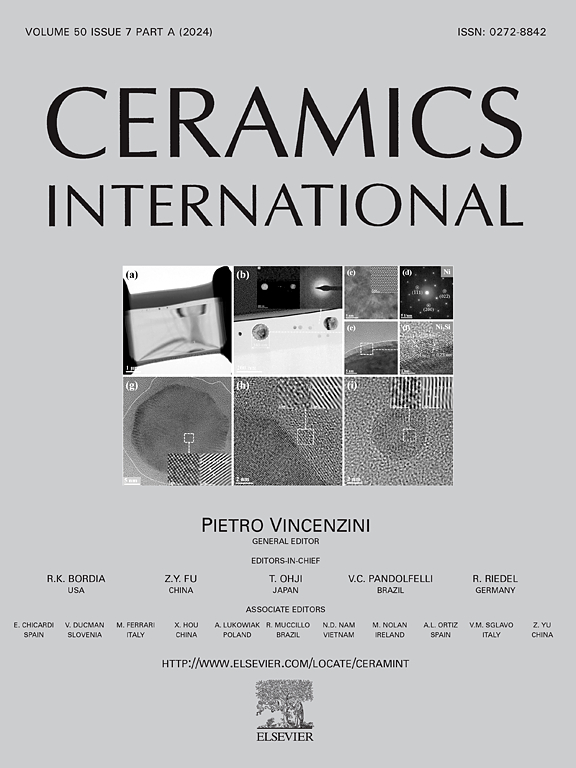放电等离子烧结降低质子陶瓷燃料电池BaZr0.4Ce0.4Y0.1Yb0.1O3-δ电解质的烧结温度
IF 5.1
2区 材料科学
Q1 MATERIALS SCIENCE, CERAMICS
引用次数: 0
摘要
质子陶瓷燃料电池(pcfc)需要密集的电解质来最小化晶界电阻,并有效地隔离电极的气氛,通常需要超过1500°C的高温致密化。这种情况会导致阳极烧结和Ba的挥发。为了解决这些问题,研究人员提出了一种具有高热效率和均匀加热特性的火花等离子烧结(SPS)技术。这项研究标志着SPS在阳极负载型pcfc制造中的首次应用。采用SPS工艺制备的单细胞在650°C和600°C下的峰值功率密度分别为0.802和0.526 W cm−2。这些结果表明,与通过传统高温共烧结方法生产的电池相比,电化学性能有了实质性的提高。这种增强是由于阳极的比表面积和孔隙率增加。此外,用SPS工艺制备的pcfc表现出优异的稳定性。总之,提供了一种制备PCFC单体电池的新方法,不仅有效地降低了烧结成本和时间,而且显著提高了电池的电化学性能。本文章由计算机程序翻译,如有差异,请以英文原文为准。
Lowering the sintering temperature of BaZr0.4Ce0.4Y0.1Yb0.1O3-δ electrolyte by spark plasma sintering for protonic ceramic fuel cells
Protonic ceramic fuel cells (PCFCs) necessitate dense electrolytes to minimize grain boundary resistance and effectively isolate the atmospheres of the electrodes, typically requiring high densification temperatures exceeding 1500 °C. Such conditions can result in anode sintering and the volatilization of Ba. To address these challenges, a promising alternative, spark plasma sintering (SPS) technology characterized by high thermal efficiency and uniform heating, was proposed. This study marks the inaugural application of SPS in the fabrication of anode-supported PCFCs. Single cells prepared using the SPS process demonstrated peak power densities of 0.802 and 0.526 W cm−2 at 650 and 600 °C, respectively. These results represent a substantial improvement in electrochemical performance compared to cells produced via traditional high-temperature co-sintering methods. The enhancement is attributed to the increased specific surface area and porosity of the anode. Furthermore, PCFCs fabricated with the SPS process exhibit exceptional stability. In conclusion, a novel method was provided for preparing PCFC single cells that not only effectively reduces sintering costs and time but also significantly enhances the electrochemical performance of the cells.
求助全文
通过发布文献求助,成功后即可免费获取论文全文。
去求助
来源期刊

Ceramics International
工程技术-材料科学:硅酸盐
CiteScore
9.40
自引率
15.40%
发文量
4558
审稿时长
25 days
期刊介绍:
Ceramics International covers the science of advanced ceramic materials. The journal encourages contributions that demonstrate how an understanding of the basic chemical and physical phenomena may direct materials design and stimulate ideas for new or improved processing techniques, in order to obtain materials with desired structural features and properties.
Ceramics International covers oxide and non-oxide ceramics, functional glasses, glass ceramics, amorphous inorganic non-metallic materials (and their combinations with metal and organic materials), in the form of particulates, dense or porous bodies, thin/thick films and laminated, graded and composite structures. Process related topics such as ceramic-ceramic joints or joining ceramics with dissimilar materials, as well as surface finishing and conditioning are also covered. Besides traditional processing techniques, manufacturing routes of interest include innovative procedures benefiting from externally applied stresses, electromagnetic fields and energetic beams, as well as top-down and self-assembly nanotechnology approaches. In addition, the journal welcomes submissions on bio-inspired and bio-enabled materials designs, experimentally validated multi scale modelling and simulation for materials design, and the use of the most advanced chemical and physical characterization techniques of structure, properties and behaviour.
Technologically relevant low-dimensional systems are a particular focus of Ceramics International. These include 0, 1 and 2-D nanomaterials (also covering CNTs, graphene and related materials, and diamond-like carbons), their nanocomposites, as well as nano-hybrids and hierarchical multifunctional nanostructures that might integrate molecular, biological and electronic components.
 求助内容:
求助内容: 应助结果提醒方式:
应助结果提醒方式:


